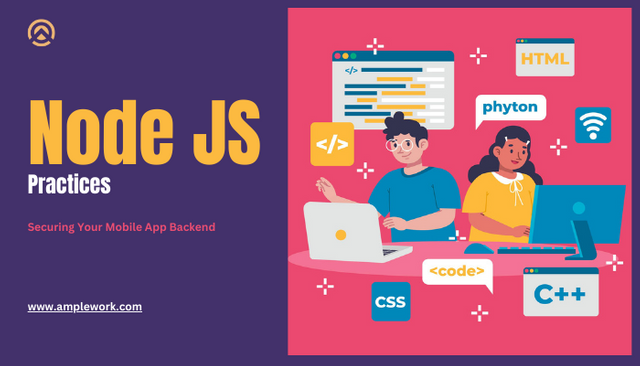
In recent years the security of mobile apps has become the most important issue due to the increase in the number of cyber-attacks. These cyber security issues sometimes prove to be much more damaging to your business’s private and confidential data that is stored in the backend. Since NodeJS is one of the robust mobile app development platforms, it has a much wider scope in the upcoming future. That’s the reason why the security of these mobile apps is also necessary. Since the competition is growing in the market of Los Angeles, that’s the reason why security has become an integral part of any mobile app crafted by you hire node js developers.
We are all aware that any mobile app development services are based on multiple ends. The first one is the front end, which is visible to the users so they can perform their desired operations. The second one is the front end which is not visible to the users but can only perform the operations in the background like the data storage, command-based operations, and many others. In this blog, we will be discussing the best practices to secure your mobile application.
Understanding The Significance of Backend Mobile App Security
The backend of your mobile app is the engine that powers it. Any security vulnerabilities here can lead to data breaches, compromising user trust and your app's reputation. Not only your app’s reputation but also your business’s prestige. These data breaches and vulnerabilities may sometimes cause serious financial harm to your business’s funds. That’s the main reason why the backend of your mobile app must be secure and less vulnerable so that the attackers can’t access private business data by practicing any of the cyber-attacks on your app.
Securing Node JS Applications Best Practices
1. Authentication and Authorization: You should Implement robust authentication and authorization mechanisms to ensure that only authorized users can access your backend resources. None other than these users can access it without the required permissions given by the administrator. It is considered one of the most efficient and decisive practices to secure your mobile app. As it enables businesses to set up proper login credentials, only the allowed users can access the backend with the credentials set for them.
2. Input Validation: You should validate user inputs rigorously to prevent common security vulnerabilities like SQL injection and cross-site scripting (XSS) attacks. These attacks are considered the most harmful, causing severe damage to your backend. It can cause damage like data modification, and permanent deletion of data making you suffer from data loss. That’s the reason why you should continuously validate the user inputs to prevent you mobile app development from serious cyber-attacks.
3. Encryption and Data Protection: Encrypt sensitive data both in transit and at rest. Use industry-standard encryption protocols to safeguard user information. Encrypting sensitive data is one of the most essential steps for securing the backend. You should hire node.JS developer that dedicatedly takes care of this encryption and decryption terminology.
4. Regularly Update Dependencies: Keep your Node.JS and third-party dependencies up to date to patch known vulnerabilities. The latest security patch consists of a wide range of security aspects, making your mobile app less vulnerable. It enhances your security so that your mobile app can defend against any form of cyber-attack. Updating to the latest security patch or updating to the latest node versions can make your mobile app more efficient and smoother, securing the backend with efficiency.
5. Monitoring and Logging: Set up comprehensive monitoring and logging to detect and respond to security incidents promptly. For this, you need to hire dedicated node.js developers In Los Angeles. Since it is a continuous process enhancing the security of your mobile app with efficiency.
6. Implementing Security Headers: Use security headers like Content Security Policy (CSP) and HTTP Strict Transport Security (HSTS) to mitigate common web vulnerabilities. Just because these vulnerabilities can invite attackers to practice cyber security attacks on your system reduces its capabilities and causes serious damage.
7. Third-Party Integrations: Carefully check and secure third-party integrations to prevent potential security risks. Sometimes these third-party applications are equipped with malicious content. This leads to infecting the mobile app with malicious code or viruses, leading to corrupting your backend.
8. Backup and Disaster Recovery: Regularly back up your data and have a disaster recovery plan in place to minimize downtime in case of a breach. You must regularly back up your data available in the backend to make it completely safe and secure even during cyber-attacks on your mobile apps.
9. Security Testing: Perform regular security assessments, including penetration testing and code reviews, to identify and address vulnerabilities. As we have already discussed, these vulnerabilities can cause serious damage and data breaches, compromising the security of your mobile apps.
10. Incident Response Plan: Have a well-defined incident response plan to contain and mitigate security breaches effectively. You should already prepare an incident response plan so that in case of attacks you can recreate your mobile app much more securely and efficiently.
Read More: 9 Node.js Development Trends to Watch Out For in 2023
Here are Some Frequently Asked Questions
Q. What is the significance of rate limiting in backend security?
A. Rate limiting helps prevent misuse of your APIs, reducing the risk of denial-of-service and many other harmful attacks.
Q. How often should I update my Node.js dependencies for security?
A. Regularly update your dependencies as soon as security patches are released, typically following a quarterly schedule.
Q. What should I include in my disaster recovery plan for my mobile app backend?
A. A disaster recovery plan should include data backup procedures, server failover mechanisms, and communication plans for notifying stakeholders.
Q. How can I educate my users about mobile app security?
A. Provide clear and concise in-app messages, tutorials, or articles on security best practices, and encourage users to enable security features like two-factor authentication.